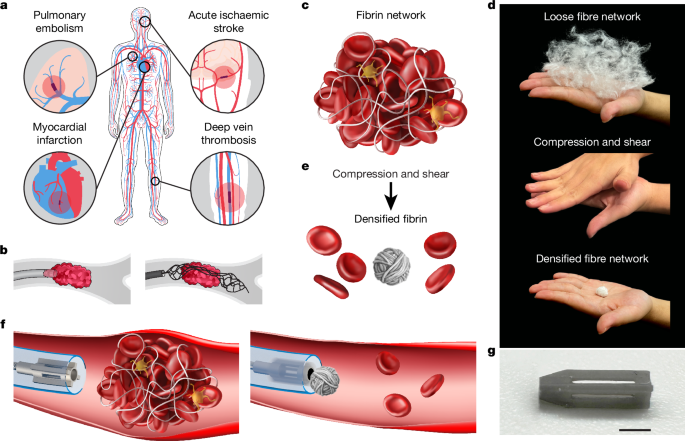Mackman, N. Triggers, targets and treatments for thrombosis. Nature 451, 914–918 (2008).
Derex, L. & Cho, T.-H. Mechanical thrombectomy in acute ischemic stroke. Rev. Neurol. (Paris) 173, 106–113 (2017).
Bhogal, P., Andersson, T., Maus, V., Mpotsaris, A. & Yeo, L. Mechanical thrombectomy—a brief review of a revolutionary new treatment for thromboembolic stroke. Clin. Neuroradiol. 28, 313–326 (2018).
Karthikesalingam, A. et al. A systematic review of percutaneous mechanical thrombectomy in the treatment of deep venous thrombosis. Eur. J. Vasc. Endovasc. Surg. 41, 554–565 (2011).
Boisseau, W. et al. Direct aspiration stroke thrombectomy: a comprehensive review. J. Neurointerv. Surg. 12, 1099–1106 (2020).
Munich, S. A., Vakharia, K. & Levy, E. I. Overview of mechanical thrombectomy techniques. Neurosurgery 85, S60–S67 (2019).
Loffroy, R. et al. Percutaneous rotational mechanical atherectomy plus thrombectomy using Rotarex S device in patients with acute and subacute lower limb ischemia: a review of safety, efficacy, and outcomes. Front. Cardiovasc. Med. 7, 557420 (2020).
Jadhav, A. P. et al. First pass effect with neurothrombectomy for acute ischemic stroke: analysis of the systematic evaluation of patients treated with stroke devices for acute ischemic stroke registry. Stroke 53, e30–e32 (2022).
Ciampi-Dopazo, J. J. et al. Aspiration thrombectomy for treatment of acute massive and submassive pulmonary embolism: initial single-center prospective experience. J. Vasc. Interv. Radiol. 29, 101–106 (2018).
Podlasek, A., Dhillon, P. S., Butt, W., Grunwald, I. Q. & England, T. J. Direct mechanical thrombectomy without intravenous thrombolysis versus bridging therapy for acute ischemic stroke: a meta-analysis of randomized controlled trials. Int. J. Stroke 16, 621–631 (2021).
Jolugbo, P. & Ariëns, R. A. Thrombus composition and efficacy of thrombolysis and thrombectomy in acute ischemic stroke. Stroke 52, 1131–1142 (2021).
Kaesmacher, J. et al. Risk of thrombus fragmentation during endovascular stroke treatment. Am. J. Neuroradiol. 38, 991–998 (2017).
Wong, G. J. et al. Frequency, determinants, and outcomes of emboli to distal and new territories related to mechanical thrombectomy for acute ischemic stroke. Stroke 52, 2241–2249 (2021).
Shah, K. J. & Roy, T. L. Catheter-directed interventions for the treatment of lower extremity deep vein thrombosis. Life 12, 1984 (2022).
Nogueira, R. G. et al. Thrombectomy 6 to 24 hours after stroke with a mismatch between deficit and infarct. N. Engl. J. Med. 378, 11–21 (2018).
Chueh, J.-Y., Puri, A. S., Wakhloo, A. K. & Gounis, M. J. Risk of distal embolization with stent retriever thrombectomy and ADAPT. J. Neurointerv. Surg. 8, 197–202 (2016).
Costalat, V. et al. Prognostic factors related to clinical outcome following thrombectomy in ischemic stroke (RECOST study). 50 patients prospective study. Eur. J. Radiol. 81, 4075–4082 (2012).
Chalumeau, V. et al. Anterior cerebral artery embolism during thrombectomy increases disability and mortality. J. Neurointerv. Surg. 10, 1057–1062 (2018).
Chernysh, I. N. et al. The distinctive structure and composition of arterial and venous thrombi and pulmonary emboli. Sci. Rep. 10, 5112 (2020).
Rossi, R. et al. Correlation between acute ischaemic stroke clot length before mechanical thrombectomy and extracted clot area: impact of thrombus size on number of passes for clot removal and final recanalization. Eur. Stroke J. 6, 254–261 (2021).
Nader, E. et al. Blood rheology: key parameters, impact on blood flow, role in sickle cell disease and effects of exercise. Front. Physiol. 10, 1329 (2019).
Shin, D. W. et al. Increased plasma viscosity in plasma cell dyscrasia and whole blood viscosity in polycythemia vera. Clin. Hemorheol. Microcirc. 70, 59–67 (2018).
Boodt, N. et al. Mechanical characterization of thrombi retrieved with endovascular thrombectomy in patients with acute ischemic stroke. Stroke 52, 2510–2517 (2021).
Chueh, J. et al. Mechanical characterization of thromboemboli in acute ischemic stroke and laboratory embolus analogs. Am. J. Neuroradiol. 32, 1237–1244 (2011).
Di Maria, F. et al. Identifying the predictors of first-pass effect and its influence on clinical outcome in the setting of endovascular thrombectomy for acute ischemic stroke: results from a multicentric prospective registry. Int. J. Stroke 16, 20–28 (2021).
Bai, X. et al. Influence of first-pass effect on recanalization outcomes in the era of mechanical thrombectomy: a systemic review and meta-analysis. Neuroradiology 63, 795–807 (2021).
Srivatsa, S. et al. Cerebral vessel anatomy as a predictor of first-pass effect in mechanical thrombectomy for emergent large-vessel occlusion. J. Neurosurg. 134, 576–584 (2020).
Zaidat, O. O. et al. First pass effect: a new measure for stroke thrombectomy devices. Stroke 49, 660–666 (2018).
Gunnal, S. A., Farooqui, M. S. & Wabale, R. N. Study of middle cerebral artery in human cadaveric brain. Ann. Indian Acad. Neurol. 22, 187–194 (2019).
He, G. et al. Mechanical thrombectomy injury to the arterial wall: a comparison between catheter aspiration and stent retriever. Eur. J. Radiol. 139, 109723 (2021).
Thielicke, W. & Sonntag, R. Particle image velocimetry for MATLAB: accuracy and enhanced algorithms in PIVlab. J. Open Res. Softw. 9, 12 (2021).


